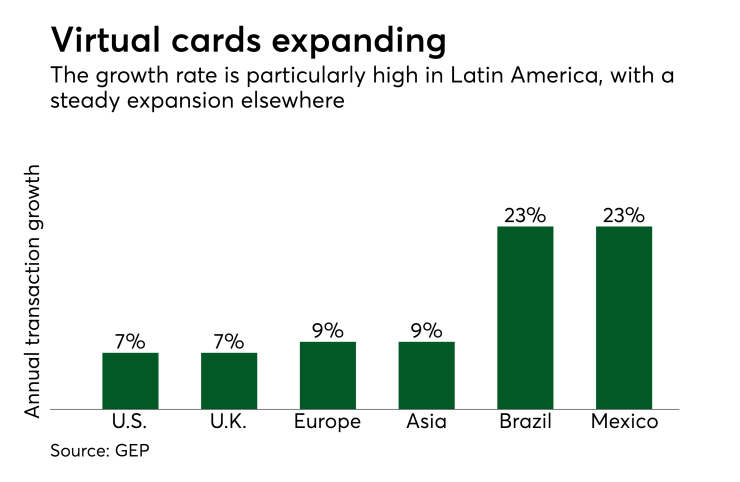The B-to-B payments landscape is expanding. With a greater push toward convenience, new technologies are entering the space and reshaping how businesses pay their bills. But the transition to new payment options isn’t always easy. These innovative payment technologies often bring new challenges to the invoice-to-cash process.
Virtual cards are one of those payment technologies.
Used to safeguard one-time-use forms of payment, virtual cards are auto-generated credit card numbers that accounts payable (A/P) departments provide to their suppliers. The use of virtual cards is growing almost

These single-use accounts are growing in popularity for many reasons, including the fact that virtual cards offer more visibility and control over the buyer’s payments, resulting in a more streamlined process for A/P departments. Also, the automation of the account reconciliation process reduces the risk of human error impacting the invoice-to-cash process. And virtual cards expire after a specific amount of time and can be set to the exact cost of the bill, cutting down the risk of theft or fraud.
Despite their many benefits, virtual cards come with a unique set of challenges for suppliers and the accounts receivable (A/R) side of the invoice-to-cash process. Here are three challenges virtual cards bring to B-to-B payments and how businesses are overcoming them.
Higher Fees. Suppliers using virtual card numbers for payments are typically charged interchanges fees on completed transactions. These fees can quickly add up, and often cost suppliers an average of 2.5% of the payment, per transaction.
Security Gaps. Though virtual cards bring improved security to payments made by A/P departments, there are still some risks on the A/R side. Adhering to the appropriate security protocols to accept virtual card payments may be costly for suppliers and can potentially open the door to the risk of data breaches.
Manual Processes. Issuing single-use numbers is an automated process, but the same can’t be said for processing. In many cases, A/R departments manually retrieve the virtual card number and remittance information, process the payment and move cash into their ERP system.
Using an automated solution to process virtual card payments is the first step in overcoming the challenges of this payment technology. A/R departments can benefit from a solution that includes a comprehensive electronic invoice presentment and payment (EIPP) portal to completely automate the payments process. It’s important to find an EIPP portal that accepts payment, generates the payment file, integrates with an existing ERP and automatically closes out each invoice as it’s paid. The solution should also be PCI compliant and maintain the latest encryption technologies and security standards.
Accepting virtual cards in an efficient manner can improve customer satisfaction and accelerate cash flow. As virtual cards become commonplace in the B-to-B payments landscape, companies that opt for automation in their invoice-to-cash process stand to benefit.





